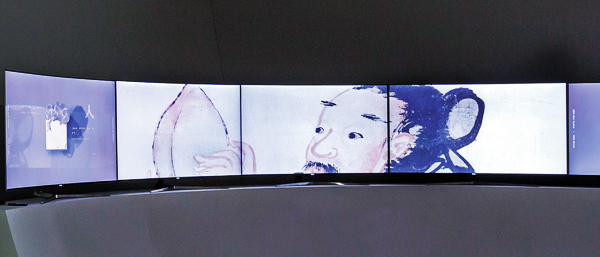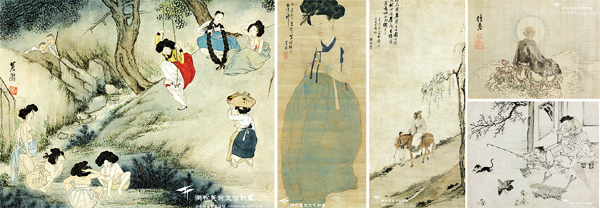A window into daily life of the Joseon era

The Kansong Art Museum’s sixth exhibition at the DDP includes three media artworks in an effort to appeal to younger audiences. Above is the work by media artist and photographer Brian Ku, which shows 10 paintings in super-high resolution. [KANSONG ART AND CULTURE FOUNDATION]
Such art has become especially valuable as substantial historical records when it comes from a time when cameras didn’t exist, as it allows future generations to get a glimpse of the daily lives of their ancestors and understand their way of living.
The daily lives of both commoners and scholars spanning 500 years during the Joseon Dynasty (1392-1910) can be witnessed at the Kansong Art Museum’s sixth exhibition at the Dongdaemun Design Plaza in central Seoul, which kicked off Wednesday. About 80 genre and figure paintings by 33 artists, including the famous full-time painter Kim Hong-do (1745-1806), also called Danwon, who is known to have been the favorite painter of King Jeongjo (1752-1800), the 22nd ruler of Joseon.
“I believe genre and figure paintings are the best index that correctly shows the ideals of that era,” said Baik In-san, senior researcher at the Kansong Art Museum. “The general public can learn about the people of the Joseon Dynasty’s way of living and see what’s different and what’s similar from today, while those who have a bit more understanding of the paintings and culture of the time can have fun by reading between the lines.”
For instance, in a painting by Shin Han-pyeong (1735-1809) of his family titled “Loving Mother Caring for Her Children,” a mother is shown breastfeeding a baby boy in her arms. A little girl, who looks like the oldest daughter, is sitting down next to her mother, while a little boy is standing next to his mother crying. It seems like he’s despairing that his baby brother has stolen his place.
“Once you realize that painter Shin Han-pyeong is the father of Shin Yun-bok [1758-unknown],” said Tak Hyun-gyu, a researcher from the Kansong Art Museum, “you’ll notice that the little boy crying in the painting is Shin Yun-bok, who is one of the master painters of the Joseon Dynasty. It’s quite fun to witness such a great painter we know crying like a baby because he no longer has his place in his mother’s arms.”
“Korean Genre and Figure Paintings: Scenes of Everyday Life, Ideals and Recreation” is the sixth show the Kansong Art Museum has organized following the opening of DDP in 2014 in an effort to share its collection with the public. The museum, which is the country’s first private museum, located in Seongbuk District, northern Seoul, used to be somewhat closed to the public, holding only two-week-long exhibitions twice a year.

The Kangsong Art Museum is holding an exhibit at the DDP of genre and figure paintings spanning 500 years of the Joseon Dynasty (1392-1910). The paintings include, clockwise from left: Shin Yun-bok’s “A Dano Day Scene” and “A Beauty”; Kim Hong-do’s “Hearing a Birdsong on Horseback” and “Old Buddhist Monk Praying to Buddha”; and Kim Deuk-sin’s “Feral Cat Steals a Chick.” [KANSONG ART AND CULTURE FOUNDATION]
In an effort to connect with young visitors, the Kansong Art Museum tried collaborating with two media artists for the first time for this exhibition.
Media artist Lee Lee-nam recreated Kim Hong-do’s painting “Hearing a Birdsong on Horseback” as media art that even includes the sounds of birds chipping. In Lee’s artwork, the scene of a young scholar enjoying a spring afternoon, riding on a horseback, listening to the birds chipping in a willow tree, transforms into a scene of a beautiful starry night as well.
“Many people have no problem coming to see traditional artwork at Kansong, but there are still a lot of people who find it unfamiliar and strange to enjoy such artwork,” said Baik. “So we tried working with media artists for this exhibition to help those young visitors who are especially exposed a lot to media while thinking of ways to modernize traditional artwork. However, I still want traditional artwork to be the center of attention and the media works only used as support.”
The second section of the exhibit includes genre paintings by artists like Kim Myeong-guk (1600-after 1662), Jeong Seon (1676-1759) and Kim Hong-do painted and figure paintings such as one of a Taoist hermit who consumed stolen peaches from Xi Wangmu’s garden and lived for thousands of years, a monk who crossed a river on a single reed leaf, and a recluse gazing at the moon in joy. According to the museum, these works “represent people’s hopes and desires.”
Since both hermits and monks are portrayed as bald-headed, it’s quite difficult for the general public to differentiate the two. Tak says if you look closely, hermits have especially shiny heads and beards.
“Moreover, hermits’ heads tend to be shown larger than the monks,” he said.
In the last section of the exhibit, famous paintings including Shin Yun-bok’s “Double-Sword Dance,” “A Dano Day Scene” and “A Beauty” are on display. Media artist and photographer Brian Ku’s media work that displays 10 enlarged paintings in super-high resolution can also be found in this section.
BY YIM SEUNG-HYE [sharon@joongang.co.kr]
“Korean Genre and Figure Paintings: Scenes of Everyday Life, Ideals and Recreation” runs until Aug. 28 at the DDP. Admission is 8,000 won ($7). The opening hours of the Design Museum at the DDP are 10 a.m. to 7 p.m., but are extended to 9 p.m. on Wednesdays and Fridays. The museum is closed on Mondays.
Go to Dongdaemun History and Culture Park Station, lines No. 2, 4 and 5, exit 1 or 2.










with the Korea JoongAng Daily
To write comments, please log in to one of the accounts.
Standards Board Policy (0/250자)